You can find it reproduced on hundreds of paranormal themed websites and in many ghost books. The photo is usually accompanied by a short bit of text that describes the scenario. Mrs. Mabel Chinnery snapped the photo in March of 1959 in England. She took the photo of her husband in the car, but when the photo was developed she could see that her mother (Mrs. Ellen Hammell) was in the photo sitting behind him—but the photo was taken during a visit to the late Mrs. Hammell’s grave! How could she now appear in the back seat?! [cue dramatic music]
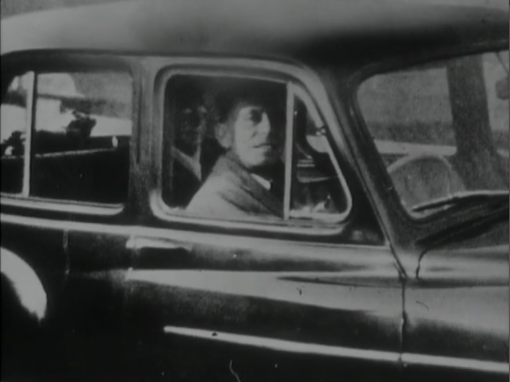
A screen shot from Arthur C. Clarke’s World of Strange Powers offers the clearest copy of the photo by Mrs. Mabel Chinnery allegedly showing a back-seat ghost.
The phrasing of the stories accompanying the photo tends to follow closely the short blurb that was included in Time-Life’s Hauntings, which was part of the widely popular “Mysteries of the Unknown” series of books on paranormal topics promoted in the late 1980’s and early 1990s. Their mystery-mongering commercials were etched into the memories of my generation. Many of them included memorable phrases like “How can you explain this?” and “Read the book!” along with reenactments and new age electronic music. The way the Hauntings volume of the series described this particular photograph was quite underwhelming for an image that is supposed to demonstrate such a remarkable concept as continued existence of our identities after death. A caption under the photo says:
An expert who examined the photo above said the image of Mabel Chinnery’s dead mother in the rear seat could not be a reflection or an overprint. “I stake my reputation on the fact that the picture is genuine,” he declared.
Who is this expert? What does the word genuine mean here? Alas, the identity of this person may be lost to us (if such a person existed) but we can tell where the quote originated and it wasn’t in the Time-Life book. The original news report concerning this photo (at least in the United States) came in the June 28, 1959 edition of Parade magazine (now a glossy newspaper insert). In that article we get a more detailed account of the photograph’s history, but there is still little to go on, and in the grainy accompanying printed photo it would have been difficult to see important details.
The text of the Parade article includes this phrase:
At least one photo expert says the picture is genuine, explaining: “The lady in back can’t be the result of a double exposure. If it were, the door’s upright wouldn’t block off part of her face. And she can’t be a reflection in the window, either.”
Here, the unnamed photo expert does not “stake his reputation” but he doesn’t need to if he’s not going to have his name included.
It is likely that Parade picked up the story from a British paper, but I haven’t tracked down the original version, though it is probable that the contents are identical if this is a wire story. There is also an accompanying photo of the late Mrs. Hammell. The story includes that the date the photo was snapped was March 22, 1959. We can confirm through online databases that a Mrs. Ellen Hammell was a real person and that her death records conform to the story laid out by the Chinnery’s.
I wanted to know what kind of car was in the photo so I could get a better idea of how the vehicle was arranged inside. I was very pleased indeed at what has to be my most successful “crowd-sourced” research collaboration to date. Friends, family and fans of MonsterTalk responded to my inquiries and quickly tracked down the make and model of the car. It is a Hillman Minx, probably a Mark III or Mark IV. Here is a fantastic modern photo of the same type of vehicle from almost the exact same angle as that taken in Mrs. Chinnery’s photo.
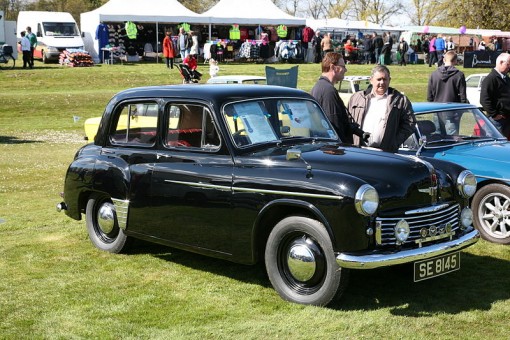
1953 Hillman Minx. (Image by Graham Robertson, via Wikimedia Commons. Used under Creative Commons Attribution 2.0 Generic license).
Certainly I’m not the first skeptic to investigate the photo. Some accounts mention that there were questions about whether or not the photo could have been a double-exposure. In film-based photography, it is possible to expose the same film to two different photographic scenes and create an image composed of material from both exposures. This doesn’t come up in digital photography, but it was the source of countless fake or accidental ghost photos in the past. In the book Ghost Photos, despite many uncritical entries on such photos, author Melvyn Willin writes:
In this case, the possibility of a double exposure must be considered. On the right is what at first seems to be the door pillar of the far side of the car, but isn’t it much too far forward, aren’t the windows too big, and does the curved right side look like a tree trunk? The supposed mother’s figure looks unnaturally close to the front seat and couldn’t be sitting on the back seat. Even Mr. Chinnery’s face seems too big.
Well, I don’t think I can agree with all of those concerns, but Mrs. Hammell does seem to be sitting a bit far forward—though not so far that this single feature would flag the image as a double-exposure, in my opinion.
A very thorough examination of the photo was performed in Arthur C. Clarke’s World of Strange Powers television series. In the 1985 episode titled “Ghosts, Apparitions and Haunted Houses,” several photographs are investigated including the famous “Cottingley Fairies” photos which fooled Sir. Arthur Conan Doyle. Dr. Steve Gull and Tim Newton use early computer photographic analysis and conclude that there are at least two really strong indicators that the photo is an accidental double-exposure. I’m including a couple of stills to help show these features. First, there is something that looks like a shoulder on the right-hand side of the rear passenger window. It might appear to be the shoulder of the alleged ghost, but that would give her a very odd body configuration.
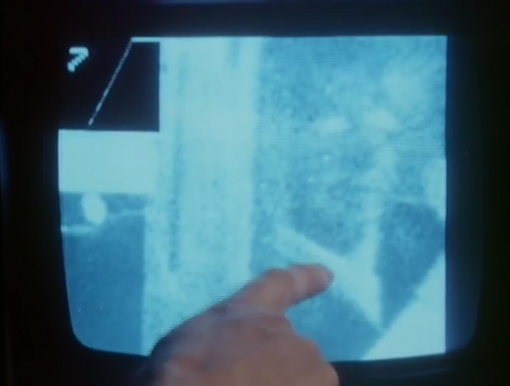
Dr. Steve Gull and Tim Newton examined the photo using early digital photography software for Arthur C. Clarke’s documentary series.
The second feature strongly suggesting double-exposure is that the white collar of the alleged back-seat ghost is visible through the metal window frame that splits the front and back doors. Her collar should be truncated where the collar meets the frame—but instead appears to extend through the solid black metal, which is what we would expect of two merged images.
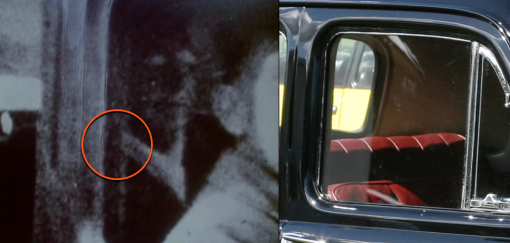
Mrs. Hammell’s white collar is visible through solid metal, a strong indicator of a composite image. To the right you can see the same solid feature in a clearer photo of a Minx driver’s window.
I think the most likely scenario is that Mrs. Chinnery took a photo of her mother in an armchair shortly before the old woman died. Then, with the same roll of film in the camera, she accidentally took a second shot of her husband without forwarding the film to the next frame.
I do not know what kind of camera Mrs. Chinnery had, but I have seen some accounts that said she shot it with an Eastman-Kodak Brownie. There were many popular models on the market when the photo was taken, but the Brownie was a very popular camera. I reached out to an expert on antique Brownie cameras because I wanted to learn more about how easily one might accidentally take a double-exposure on one. Chuck Baker at www.brownie-camera.com was kind enough to answer my inquiries in robust detail.
My first question was about double-exposure prevention on these kinds of cameras. The Brownie was not the first to introduce double-exposure prevention, and even after they started offering it, it was not standard on all models. I asked Mr. Baker, “When did the Brownie introduce double-exposure prevention?”
“I’m assuming you mean which was the first Brownie camera that had double-exposure prevention. There weren’t that many Brownies that did.
There are two types of double-exposure prevention.1: *Manual Protection: Those that had a little slide that would manually be slid over the actual exposure trigger or a toggle type switch that did the same thing. The user would have to remember to slide it over so that it would not double expose by the photographer or by mishandling.
2: *Automatic Protection: Those that prevent a shutter release until the film is wound to the next exposure. Much like any modern “manual” camera where the act of winding cocks the shutter for the next exposure. This is the least common way for a Brownie to have been protected from double-exposure.”
He went on to give details about the years and models of the various versions and the way they implemented the feature. If you’re interested in antique cameras and photography I’d recommend checking out his website.
I also asked, “Before it was added, how easy or hard was it to accidentally take a double exposure?”
“It’s sometimes funny how things happen. Last weekend I was using, among other cameras, a model that did not have double-exposure prevention and accidentally did a double exposure without knowing it until I processed the film that night. So the answer would be: very easy!
I’ve made it a practice to always wind to the next frame so the camera is always ready to use. What occasionally happens is the lever gets tripped when putting the camera in a bag or pocket…then when it’s taken out, the new shot is made over the mistaken lever trip. It doesn’t happen often, however, even after 50 years of using cameras, this still happens.”
Without knowing that Mrs. Chinnery was using a Brownie in particular, this additional information merely serves to remind one that it was quite possible to accidentally produce double-exposures with cameras of the time. Furthermore, out of all such mistakes it seems statistically inevitable that some of them would occasionally produce startling results where a person who could not possibly be present appears to have shown up in the composite results. I can only imagine how powerful and emotionally moving such an event would be if the circumstances, such as in this case, were such that the person had in fact died before the resulting composite photo was produced. Even if there is a perfectly reasonable non-paranormal explanation for such a photo, it must have been very impactful for Mrs. Chinnery and her husband.
Another camera mentioned as a candidate for Mrs. Chinnery’s camera was the Corfield Periflex. It is not necessary to know what kind of camera was used in order to recognize that cameras sometimes take this kind of photographic error. In this particular case the results were just especially suggestive and emotionally impactful to the photographer and her husband.
Just before publishing this, I was referred to a companion volume to the Arthur C. Clarke series. In Chronicles of the Strange and Mysterious, this excerpt challenges the idea that this was an accidental double-exposure:
“…in fact, it was the last frame of a film on which Mabel had photographed the old lady’s grave.”
This is the only reference I’ve encountered where mention was made of what other items were on the roll of film. It is unclear from the passage how the narrator knew this new detail. Did the Chinnerys say this? Did the authors infer it? (Edit 4-23-2015: Readers more alert than I was last night when I added this paragraph have pointed out that the original article included this detail!) If accurate, it calls into question the idea that this was an accidental double-exposure. If this tidbit about other photographs on the roll being taken of the grave prior to this last shot is correct, then an accidental double-exposure scenario becomes a convoluted scenario involving rolling the film forward to the last frame, taking a photo of the mother-in-law, rewinding the film, taking the whole role of shots and then forgetting that the whole “last frame” accident took place and then shooting the new photo of the car over the old photo of the mother.
If this detail about there being previous shots of the grave could be confirmed, I would think it less likely that the double-exposure was accidental, not more likely that the image showed a ghost.
I continue to be fascinated by famous alleged ghost photos. It’s been a topic that entranced and frightened me as a child. I was unable to stop reading about them, yet afraid to look at the photos for very long. As an adult I became more interested in the facts behind the photos, having discovered a pattern of what appears to be deliberate misinformation in the field of ghost research. There are many self-described researchers who are really just enthusiasts. They repeat legends, sometimes adding embellishments, yet seem to eschew any disconfirmatory research. I like, when I can, to help silence some of the noise in the echo-chamber of paranormal literature. This particular image has been in “top ghost photo” lists for years now, but I think we can now take down this exhibit in the gallery of ghosts with some confidence, and put it to rest.
References
- Arthur C. Clarke’s world of strange powers [Motion picture on DVD]. (1985). UK: ITV Global Entertainment.
- Chuck Baker, personal communication, February 26, 2015
- Fairley, J., & Welfare, S. (1987). Arthur C. Clarke’s chronicles of the strange and mysterious (pp. 143 – 144). London: Collins.
- The Haunted World. (1989). In J. Mcmanus (Ed.), Hauntings. Alexandria, VA: Time-Life Books.
- Willin, M. (2009). Most Famous Mysteries. In Ghost Photos: The Paranormal Caught on Film (1st ed., pp. 272 – 273). New York, NY: Metro Books.
Acknowledgements:
Special thanks to Jerry Drake, Paul Lee, Andreas Holm Hammershøj, Chuck Baker, Bridget Bell, Hayley Stevens and all the folks who helped out in the Facebook MonsterTalk group. As always, thanks to my wonderful wife @MrsDrAtlantis for helping me indulge my research obsessions.

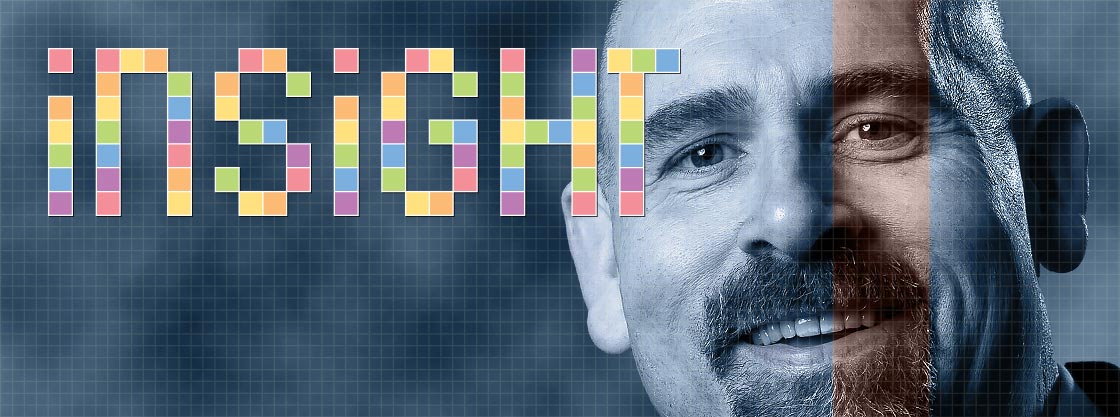
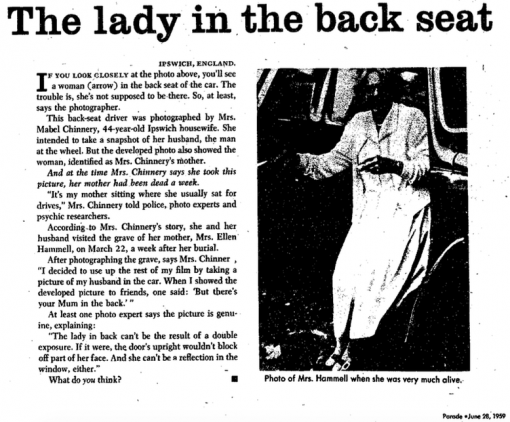
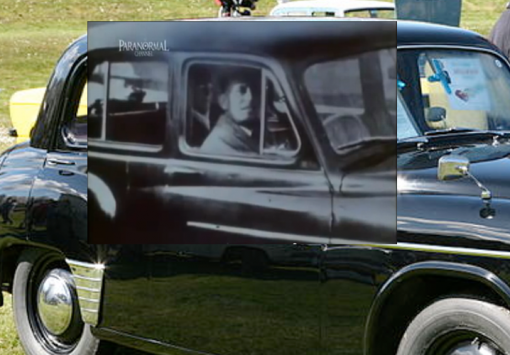
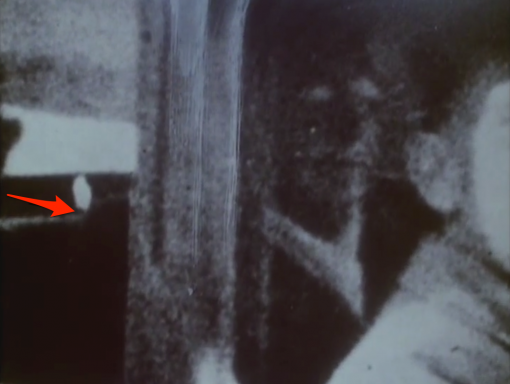
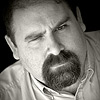








I think in retrospect this may not have been the most fortunate topic to tackle–too many unanswered questions remain. The Kodak Brownie is a vertical-feed camera; thus, if a roll is inadvertently reused, the second-pass images will be inverted with respect to those obtained on the initial pass through the camera. This is inconsistent with what is seen here. I am not a believer in ghosts as such, but a lot of the mundane explanations offered here seem strained; whether there is a straightforward explanation for this image or whether this is a genuinely profound mystery is something we have insufficient data to ascertain–the claims about what was on the rest of the roll of film are hearsay, and the film itself evidently has not survived, so no definitive “debunking” is possible here.
Let me add another, less convoluted, possibility to the double exposure idea. The film roll was simply reused. The original use was to take photos indoors, as you suggest with the woman in the arm chair. The photos were relatively dim and the film was rewound, not developed and its use forgotten. Then the roll was sometime later reused on this graveside outing. The outdoor photos were bright enough to obscure most of the notable features of the previous use. Now the signs of double exposure may have been there but were simply unremarkable relative to this eye catching, emotion grabbing image. Proof, of course not, but a plausible natural scenario that could be falsified by an examination of the remainder of the roll. Until that is possible, then the skeptics tool of suspension of judgment will rule.
The ghost is male, I think. Looks like an elderly gentleman in his late sixties or seventies.
It’s strange that a double exposure would decide to only show the most spooky part and ignore everything else. Where is all the other stuff? As others have pointed out: the reflection hypothesis is interesting.
It’s certainly interesting, but I recognise the weight of Graham and Galloway’s opinions above. It would be absolutely crucial to see what was on the film previous to this image, and whether the events happened in the order its claimed.
Hoofbeats/horses/zebras and so on.
What would also be really interesting would be to try and recreate the image itself, to see if someone sitting in the back seat of a Hillman Minx could be photographed in this position. Anyone got a Hillman Minx, a box brownie and a free afternoon?
Exciting news (to me at least): Thanks to help from another researcher into matters Fortean (Mike Dash) I now have two really great leads for tracking down the some folks directly involved in the Clarke documentaries.
I’ll let you all know what I find.
I don’t know why it can’t be an actual flesh and blood person, one that the Chinnerys did not account for after looking at the photo at a later date. Or, even Old Mama Chinnery, herself, photographed much earlier than her “greatly exaggerated demise”. That simple explanation sure would satisfy every question, and supersede every criticism.
Whoa there guys and gals!! All of this interesting speculation is based on the assumption that Mrs Chinnery was telling the truth! She may have been lying through her teeth and this may simply be a picture of her living mother and all the rest of the spiel a fabrication! Unless we can examine her mental health, motivation, veracity, integrity all these worthy scientific speculations are, sadly, irrelevant. Same is true of all “paranormal” reports. Why should the uncorroborated word of any individual be taken as any kind of robust evidence? Much more worthwhile is the study of human deception, ignorance and credulity – that is where the “paranormal” originates.
I’m not certain that this is a double exposure. I am convinced that the image shows signs of being a composite – and do not know how that could be accidental if the previous images were taken at the graveside.
It looks like a composite image to me – but I’d defer to the experts who digitally examined it in the 1980s. I will continue to attempt to contact them and the authors of books who worked on the Clarke series. Everyone is having to work with copies of copies and there may be details in the original photo which is lost in the reproduction process.
There are other ways a composite image could have been made besides double exposure, but the opportunity to use a naughty pun in the title was too much of a temptation for me.
I appreciate all the feedback – especially the feedback that disagrees with my conclusions because certitude isn’t something I trust.
I don’t like to include it in every article I write about ghost photos, but there are always overarching issues in trying to use photography to “prove” anything. No one has proven that ghosts exist. That doesn’t stop people from being haunted, and it doesn’t stop them from seeing ghosts in a variety of images. But science doesn’t recognize ghosts as a physical reality, and photography will not be the mechanism by which that might ever change.
As ever, the sceptics have sown doubt which they’ve then nurtured into certainty with their argument.
The fact that other photographs of the mother-in-law’s grave were taken before this one rules out the double-exposure hypothesis.
Also, given that the car is black, lighter elements from the other supposed photograph in the “double exposure” would show up in the car’s bodywork : unless, as another commentator has remarked, the lady was “bluescreened” into the photograph, we’d expect to see details of her surroundings in the image if this was a double exposure. As it is, we only see her where we’d expect to see someone sitting in the back of a car.
As for the lady’s scarf showing through the door pillar, this appears simply to be a case of “bleeding”, i.e. brighter areas of the image leeching into the darker ones due to what one may think of as a kind of flair, to put it simply. (The same effect as with the disappearing reseau lines on the Apollo photographs where the cross appears to be “behind” the ALSEP package.) This would be more prominent given the poor quality of the optics in the camera believed to have been used.
Also, vehicles from this era often had a kind of velvet trim around the door frame (see the faint bright line down the inside of the door frame below the scarf) which would further soften the boundary between the frame and the scarf in the photograph.
As for the dismissive comment that it’s not necessary to know what kind of camera was used, I’d say it was very necessary as, given variations in things such as the focal length of the lens, the perspective and relative positions of objects shown in photographs can change dramatically. Similarly, a photograph taken from “almost exactly” the same angle isn’t good enough when overlaying photographs such as this.
(Come on, sceptics: you’d pounce on such sloppy arguments as these in a case you were trying to debunk!)
While I’m not saying that this photograph shows a ghost, it shows no signs of being a double-exposure as is claimed by the sceptics.
James Mitchell,
England
(Photography nut, Brownie collector and former classic car owner.)
James, I don’t know that it was a fact that other photos of the grave were taken. That’s what an article said; that doesn’t make it fact. Unless we have the original roll of negatives, we’ll never know how the photo was made.
Scott
That’s a very good point you raise and one common to many “paranormal” photographs which are usually only seen as nth. generation copies in isolation.
Although I still don’t think this is a double-exposure for the reasons I state above, the real issue is not the photograph itself, but rather the claims made for it. The photograph contains no apparent visual anomalies and if it hadn’t been claimed to include an image of a ghost then I doubt if any of us would argue about it being either an accidental double-exposure or a fake.
“The lady in back can’t be the result of a double exposure. If it were, the door’s upright wouldn’t block off part of her face. And she can’t be a reflection in the window, either.”
Why can’t it be a reflection? The conditions are good for it, bright outside the car, dark inside.
By the way, if the reflected figure is even a person, it looks to me like a man with a gray mustache and beard, not a lady.
I’m surprised that no one has suggested that the image is a reflection of a person outside of the car. This would account for the white scarf crossing the black piece inside the window.
I think you are right Michael! If you look, the collar goes right up to where the window goes into the door frame! If this truly was a double exposure, I think that the collar should not stop so sharply and so conveniently on the edge of the window.
Blake, is the angle such that the rear window should not be visible through the driver side window? Your comparison picture is not quite the same angle to determine this.
It it was, it would confirm the opacity of the “Ghost”.
That was my impression too. In the old photo, the rear window probably should not be visible through the driver side window, because the rear left passenger side window is visible through it. The car is turned more toward the camera in the new color photo.
It looks to me like the husband’s window may be rolled down but this is such a grainy photo I could almost believe anything about it. I tried looking up the mechanics of how double exposure affects film but could only find tutorials on how to do this in Photoshop now (thank you, Google – you have failed again).
It’s easy to believe that the window is closed. It doesn’t look much different from the triangular section with glass or the rear right window, and the driver appears to be wearing a coat because it’s cold outside.
It’s not a double exposure, it’s a reflection in the glass on the door window, it just happens to look like a human figure.
Do ghosts really need to wear spectacles? It’s ridiculous that anyone could believe this is anything other than a double exposure (accidental or otherwise).
” “…in fact, it was the last frame of a film on which Mabel had photographed the old lady’s grave.”
This is the only reference I’ve encountered where mention was made of what other items were on the roll of film. It is unclear from the passage how the narrator knew this new detail. Did the Chinnerys say this? Did the authors infer it? If accurate, it would call into question the idea that this was an accidental double-exposure.”
The 1959 “Parade” article tell this clear enough. “After photographing the grave, says Mrs Chinnery, “I decided to use up the rest of my film by taking a picture of my husband in the car”.”
Ha – wow, good catch Valeriu! I’m embarrassed but will correct that.
Correction made – that is really troubling, if true. The image still appears to be some kind of composite but I’m stumped at how it could be accidental. In the case of the Wem Town Hall case, the photo was developed by the photographer who had the skills and equipment to create and shoot his fake image which was derived from a post card. I don’t have the research resources to find out if that was the case for the Chinnery couple, but it is a matter I’d like to know more about.
To me, while this was a scary photograph I remember from a book of scary photographs my friend owned, I remember thinking “But before GHOST can even be considered don’t we need to prove ghosts exist?” Ghost is so low down on the options that it is below “trickery” (which I don’t believe the photograph was). However there is ample proof people will promote photographs as real that are not (such as the no debunked early Nessie surgeon’s photograph). Even if everything else is disproved, ghost doesn’t get to be a choice, mainly an option awaiting proof that ghosts manifest in some way.
During a skeptic investigation of a haunted house, Travis Roy took a photograph of me that has become known as “one of the best ghost photographs ever taken in New Hampshire” By accident. The local ghost hunting group in Keene actually was touting it, until I assured them to google a bit more and figure that the photo was taken from a story about ghost hunting by a skeptic group….not real ghost.
I do think this was an accidental double exposure, and as the years went on the need to cling to a story that was comforting probably made even more evidence spring to mind. If anything, ghost and UFO stories become more detailed and stronger over the years (as Blake mentions).
Right. I’m not disagreeing with your opinion. It’s a fair opinion in MY opinion and you have obviously put some time into this (and I am not suggesting the photo is a hoax). It’s just that the claim that you have put the mystery to rest doesn’t stand up to scrutiny. We’re still left with the mystery.
When we have clear-cut proof of what happened in a given situation there can still be plausible (but wrong) explanations that match (many of) the known facts. Plausibility never explains anything.
In this case nothing has been proven or disproven.
Good questions, Michael. In a case like this I felt I needed to focus on the mechanical issues of the photograph rather than the various thought problems that arise from ghost photos as a hypothesis overall. There are a lot of questions like: Why would ghosts need glasses? Why would ghost glasses reflect light yet not be seen by the photographer? Why would ghosts wear clothes at all? Are ghost clothes the spiritual remnant of clothes that have died? Do ghosts need to conform to their human proportions or can they develop huge spiritual shoulders? And so on…
In this particular case, there are blurs in the photograph that appear to be consistent with the double-exposure hypothesis, but which are subtle and could well be subjective. The features I point out are the most easily recognizable and unambiguous and therefore, in my opinion, the ones worth including in the included images. If I lived across the pond, I’d have probably expanded my research quite a bit.
What we have here is a photo that is consistent with a composite image and the nicest interpretation is that it was an accident. I would not accuse anyone of hoaxing this unless I had additional evidence.
Another famous ghost photo, the Wem Town Hall ghost, turned out to be an outright hoax despite how much it looked like a mere accidental simulacra. While satisfying to get closure like that, it is also disappointing in that such hoaxes tend to disillusion people looking for genuine evidence of continued existence after death.
“…I think we can now take down this exhibit in the gallery of ghosts with some confidence, and put it to rest.”
I’m not very familiar with the ghostly images scene but you haven’t even offered a strong plausible explanation. The “collar through the metal” argument seems rather weak because the images you’re using are so grainy. What if that vertical white haze is an effect of light (or could it be the result of double exposure)?
Plausible explanations don’t actually debunk anything (at least not when you are trying to prove something to be false). This investigation lacks sufficient evidence to put any of three hypotheses to test (hoax, accident, something else). No matter how plausible the argument, if you yourself leave open questions then you haven’t put anything to rest.
For example, assuming the ghost hypothesis is plausible up until the first point of failure, why does the “ghost” have to be sitting on anything? If it’s incorporeal and merely projecting its image onto the film, why can it not position itself where it wishes? The mathematical cleverness of such an apparition, making itself appear in the right spot for an off-angle shot is rather impressive, don’t you think?
Assuming the double exposure hypothesis is plausible up until the first point of failure, why doesn’t the ghostly image also bleed downward into the door itself, rather than just bleed slightly into the supposed edge of the door frame? Was the poor lady sitting behind the 1950s equivalent of a blue/green screen that covered most of her body? It’s a rather precise bust shot that manages to leave out all sorts of body contours (not to mention any furniture upon which she would have sat for the original photo).
Assuming the hoax hypothesis is plausible up until the first point of failure, how could Arthur C. Clarke’s experts fail to notice any sign of splicing two images together to produce a ghostly image with little to possibly no bleed over? That would have to be a masterpiece of photographic legerdemain.
I just don’t see that you have resolved anything. It’s a mysterious, unexplained photo and probably shall always remain so.